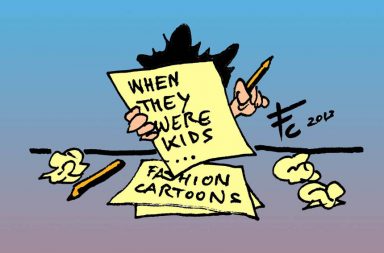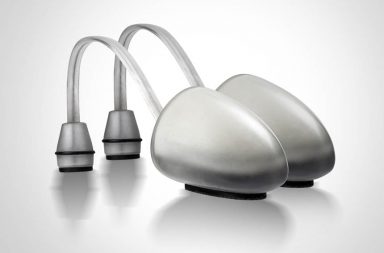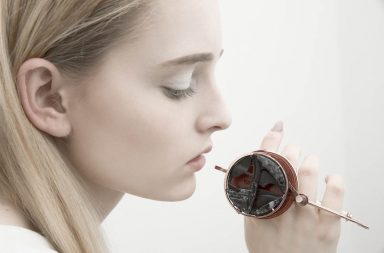Hollie White, the designer behind the ‘Ellis White’ project, has made her production process an essential part of the concept behind her designs. We here at So Catchy! Where Fashion Begins were deeply impressed with her final project for the London College of Fashion (MA Fashion Footwear) and we wanted to get to know her in person, so we headed up to London to meet her and find out more about her creative process. Industrial artisanry, hard, organic lines, that hide a history of recycling that you’ll fall in love with. Make sure you keep an eye on Hollie, we see great things in her future.

So Catchy!: Can you tell us about the materials you used and why you chose them?
Hollie White: It was a combination of things, I’ve always been attracted to industrial materials, so things like chipboard or cork or carpet underlay, they’re all reconstituted materials that are made from lots of small pieces bonded back together. I like their appearance and I also kind of like the idea of using these quite low-grade industrial materials on a luxury product. So it was partly that, and then I was also thinking about 3D printing, trying to understand exactly what it was, I went to the 3d printing show to watch how the machines work and I realized that really it’s just firing out lots of small particles with some kind of glue which sets into a hard 3D shape. I suddenly realized it wasn’t so far away from more traditional manufacturing techniques I was familiar with, so I decided to try to create my own lo-fi experiments into bonding leather particles.
The process was inspired by industrial materials, but carried out on a much smaller scale, treating the making of the product and the material itself as a kind of craft, so taking the industrial and kind of repositioning it, I guess?
SC!: So, is it also about recycling?
HW: Yes, it uses waste material. All the tiny particles of leather are cut from scrap pieces. I had so many scraps of leather lying around which I began experimenting with for convenience more than anything, then I realized what an abundance of waste there is in the production of leather goods. It’s a natural material without uniformity; so much of it has to be discarded, which means there’s an endless supply of off cuts.

SC!: Where do you find your materials?
HW: A lot came from Pittards, a leather tannery, here in the UK. I wrote to them and asked if they could send me all of the holes that they cut out when they make perforated leather, which they were happy to do but they only have black and white perforated leather. To get the colours that I wanted to add in I had a tool maker in Lancashire make me a special hole punch like a cookie cutter I could use on a big hydraulic press, which means I could go through multiple layers of scrap leather and get hundreds of particles at a time. Initially it was me and a friend with a couple of hand held hole punches, which wasn’t fun. In a whole night of almost breaking our hands, we only had a tiny bag of particles, it was so frustrating.
SC!: What’s the inspiration behind the colors you use?
HW: I tried out lots of different colours and combinations and I found that I was most drawn to the grey, black and white as a basis which reflected the industrial materials I’d started out researching. The material looked more like concrete, or granite, which become part of the attraction. People kept assuming I had carved these heels and frames from stone, and I liked that ambiguity. Also as a collection, the monotone base allowed me to be quite playful with colour as I added highlights whilst keeping a coherency across the range.

SC!: Tell me about the shapes you use…
HW: The forms were very much informed by the stone-like appearance of the material. I started thinking about each piece as a kind of time capsule or a fossil, encapsulating these particles, so they naturally took quite a geological shape.
I love the sculptures of Henry Moore and Barbara Hepworth, kind of monolithic structures, I wanted to have those bold shapes but still organic, and flowing.
I just started out experimenting, doing drawings and making shapes from clay. Especially with footwear, you move very quickly from sketching into working in 3D because everything takes shape around the last, even pattern cutting starts from 3D. I started to really like the idea of hollowing shapes out and having elements cupping each other. I wanted to remove all of the stitching and visible signs of construction so everything felt like it just fit together, like lego pieces.
Vídeo of the process
SC!: What do you plan to do now?
HW: I’m in the midst of setting up a new studio, which is equipped for sampling, with two other shoe designers, Ruth Heenan and Cat Potter.
My MA collection was made completely by hand, as one offs, so it’s a matter of refining the material and my processes so that it could be, at least partially manufactured externally. It’s about finding the right balance to capture the essence of the work in a commercially viable collection. Hopefully this will come together for wholesale next year.
SC!: Are you looking for financing?
HW: Yes! I think you’re always looking for financing when trying to start a business. There are some grants and awards you can apply for as you came out of college that help you put together another collection.

SC!: Are you planning anything now, like applying for any competitions?
HW: I was a runner up in the Deutsche Bank Award for Creative Enterprise, and I was recently awarded a SEED Fund Grant which is available to graduates from University of the Arts London. That’s enabled me buy machinery, equipment and materials I need to keep developing my work. It’s quite a lot of work in itself, just looking out for competitions and going through the application process.
SC!: What about crowdfunding?
HW: Yes, somebody suggested that to me, I haven’t looked at it in any serious way, but I really should do. At first I thought it seemed like a crazy idea and would be really difficult to get people to invest in a project, but it feels these days like it’s become a completely legitimate option for financing. I think it’s great and shows genuine support for a DIY approach to new projects.
SC!: What do you prefer, online or street retail?
HW: Personally I prefer physical retail spaces. I like to shop that way, I need to try things on, touch them. Also, a brand can really present itself in a holistic sense, through the interior, the music, the smell, it’s an experience that online retail doesn’t offer. But maybe I’m just old fashioned.
I think it’s really important for a small brand to have a retail presence whether it’s online or a physical space, it kind of validates you to sit next to other brands.
Having said that, from a business perspective, online offers an amazing opportunity for small businesses to reach more customers directly and make more margin on what they sell. I think things will increasingly move towards the online model, it’s just harder to make it personal.

SC!: And which one would you prefer, ….
HW: Here in London? I like LNCC, Dover Street Market, for looking at interesting product. I often checkout Opening Ceremony. Or have a wonder around Goodhood and Other Shop.
SC!: Have you talked with them?
HW: No, I’m not there yet. I wouldn’t want to present this collection as it’s too far from the products I would like to sell. That still needs to take shape.
SC!: Has anyone worn your shoes?
HW: Just models for some editorial shoots. nobody has worn them out on the street – I’m a bit precious with them as there is only one of each and I lost many fingertips in their making. I was actually surprised by how comfortable the models thought they were. One of them was having a photograph just of her face with the sunglasses and she was like “oh can I just put the shoes on? because I feel more comfortable standing with the heels on”. I’m not sure why that made me so proud, I guess I didn’t really trust in my own shoemaking abilities, maybe I’d just made these prototypes that look like shoes… but no, they really work!

SC!: Can you tell me more about the amazing bag?
HW: The bag is an idea that’s been in my head for a while now, the shape of the leather that kind of curves around in one piece. I lived in Japan a few years ago and the school kids, they have these amazing school backpacks, they are all kind of rounded like little parcels, and it stayed in my head. Initially I was just focusing on shoes and developing the material for those, but then I realised it lent it self so well to other products. I instantly saw that it would make brilliant sunglasses… and then as I worked on the softer rubber composition for the flat shoes, the bag came to mind, I thought, yes, it could be great as a kind of protective layer, you can set it on the ground and the leather doesn’t get scratched.
SC!: Why a backpack and not a normal bag?
HW: Well actually it’s convertible. It can be a shoulder bag as well by rearranging the straps, and you can also change them again to use it as a pannier for your bike. I was thinking about a convertible bag because during the MA I was always carrying so much stuff into college. My back was really starting to ache from hauling things on my bike and I was often so busy I’d go straight out with all of this stuff with me to meet friends, I felt like a snail with my life on my back.
I thought it would be really handy to have something more flexible and it seems to appeal, this is probably the most popular item in the collection.

SC!: Have you had a lot of interviews? Is anyone showing interest in your products?
HW: Mainly stylists who want to borrow the collection for shoots. I don’t know if you have seen it, but we have website through UAL called “showtime”, where they put up images of all the graduate work across the schools, you can filter it by course, by specialiam or by school, I find I get a lot of e-mails that way. Especially because I’m interested in starting my own business, there’s a number of programs that can help you in the first few years after graduating in terms of funding and guidance, your business plan, IP and so on. I’ve been lucky so far getting help from some really talented people. With my look book shoot for instance, I had an amazing photographer, stylist and models all pitch in, it makes a massive difference when you’re juggling so many different aspects.
SC!: Can you recommend any friends of yours that also design, or photograph, anyone from London or from another country, that you think we should take a look at?
HW: There’s my friend Louise, she has a brand called LF Markey, she graduated from Central Saint Martins maybe 7 or 8 years ago, I pretty much only want to wear her clothes. It’s beautiful workwear inspired clothing, completely practical and really fun at the same time.
Also Ruth Heenan another friend who I studied with, her footwear collection was inspired by synthetic biology and she made some completely insane footwear which reimagines how you might grow your own shoes in the future There is also Kate Langrish Smith, she does these really beautiful sculptural installation pieces, they are not wearable but they interact with the body. She studied Fashion Artefact. Hers also had a geological feel to it, she used jesmonite which looks something like very fine quart, it’s really interesting she’s made these pieces which all fit into different parts of your body. They’re really beautiful.

SC!: Do you want to go international?
HW: Yeah I think so. I mean, yeah (laughter).
I think for my products and price point I’m aiming at a particular customer and there are only so many retailers where it would work. I have to focus on the cities where that product is relevant, I guess.
SC!: Have you been contacted by anyone abroad?
HW: There was an article on a Chinese blog, and quite a few in Europe. Mostly it happens via email, we haven’t met and had a conversation like you and I, they just asked me to send them information and some images that they can feature no just a brief description. There isn’t a lot of fashion press that really scratches the surface and tries to understand the layers within the work. It seems like people are more interested in the surface level, something easy that appeals to many people. I guess it works in that you reach a wider audience, but sometimes I don’t want to frame my work like that and I’d like to read articles that tell me something more about someone else’s thought process.

SC!: At So Catchy! we like to think that we our readers are not only interested in fashion, but also in innovation, and artistic expression; we want to be a place to find inspiration across boundaries.
HW: Yeah! That’s the kind of thing I love to read about. Across all creative disciplines as well, sometimes it’s quite hard to get access to that kind of information. For this collection most of the research I did was into either building materials or product design, materials that were being used in furniture, products and architecture, it wasn’t anything that was to do with fashion, because, I mean, then you’re going to struggle to do something new.
SC!: Do you recommend any websites? Which websites do you read or watch?
HW: I always watch Ted talks, you can get so many amazing ideas from those. Nowness is great, really well curated. I like reading The Talks, the interviews feel quite personal. In terms of fashion I like Show Studio, I particularly like watching their panel discussions, because, like we were saying, a lot of fashion press seems to want to say everything is good, and it’s not always good (laughter), so I really like that Show Studio has a proper critical discussion, sometimes the guests will say that things aren’t as nice as they could be, you feel like you get real information. My favourite image based blog is “Life on Sundays” which is just a photo blog, it just has beautiful images, it’s not particularly fashion, there are just loads of beautiful images of people, bodies, of objects.

SC!: Where can we find you? Do you have a website?
HW: Yes, Elliswhite.com. I’m working on my social media, I say I’m trying because I find it difficult, I like to work away in the studio and find it hard to break away and think about self promotion. I don’t mind Instagram, because it is more visual, and less my voice, I guess (Hollie’s Instagram). It mixes my personal life and my work, I think it is more interesting than talking about the my product all the time, and I like having that view into other peoples lives. I haven’t mastered tweeting yet, maybe I’m a better listener (Hollie’s Twitter).
SC!: What about your immediate future?
HW: I’m focused on getting together my first collection. I split my time between freelancing for other brands and working for myself. At the moment I’m working on a womens collection for Fred Perry then I spend the other two days and some weekends in the studio. I’m right at the beginning now, setting up the new equipment and testing it out, experimenting with new techniques for applying the leather composite to different surfaces. I hope that I’ll have my first collection ready by September next year.
Layout and Translation by Michael Padilla
Photo Credits:
Photography: Wig Worland
Styling: Shola Branson
Models: Yasmin Everley & Felix De Pass
Hair & Make-up: Molly Peters
Retouching: Dan Saunders
Studio: Wayward Gallery




